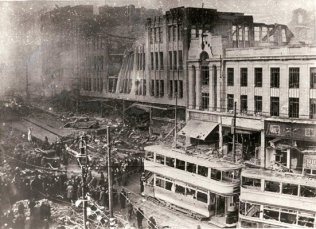These poems are the result of a walk taken early in 2010 – the last of five walks in and around Sheffield, each taking as its stimulus the notion of a one-way journey made by people at different points in history. Two of these people were my ancestors – one immigrating to the city in the 18th century; the other making the short trip from his parents’ home to the South Yorkshire Asylum. The other walks were associated with the city’s public history: the last transport of the body of Samuel Holberry the Chartist, from his mother’s home in Attercliffe to the General Cemetery; the short, swaggering journey of members of one of the razor gangs in the 1920s following their brutal, and fatal, attack on a man in the East End; and this one, tracking (albeit obliquely) the bombing runs of the German Luftwaffe who, on the nights of the 12th and 15th December 1940, brought devastation to the city.
 I say obliquely. It is understood that the bombers approached from the south-east, so my route might have brought me from Intake through Manor Top and down City Road; but looking at a map of bomb sites produced by The Star suggested that a southwestern approach would allow me to pass through a greater number of heavily bombed areas – and in order to get some sense of the impact of the Blitz, I wanted to see if I could identify any wounds or scars that still remained, as I felt this would offer a way in, creatively and emotionally, to that moment.
I say obliquely. It is understood that the bombers approached from the south-east, so my route might have brought me from Intake through Manor Top and down City Road; but looking at a map of bomb sites produced by The Star suggested that a southwestern approach would allow me to pass through a greater number of heavily bombed areas – and in order to get some sense of the impact of the Blitz, I wanted to see if I could identify any wounds or scars that still remained, as I felt this would offer a way in, creatively and emotionally, to that moment.
The route I chose, starting on Hathersage Road above Dore and travelling via Whirlow, Millhouses and Nether Edge, had other attractions. Firstly, the topography was varied, offering a range of views into and across the city as I approached the centre. It also took me through a variety of terrains – residential, commercial, manufacturing, as well as those interzonal regions of allotments, subways and derelict sites which, having little attraction for planners and heritage-mongers, tend to persist and therefore provide authentic glimpses down the cracks into some past or other. Moreover, it also provided a sociological cross-section, from the wealth of Whirlow, through middle class Nether Edge, skirting the ethnically diverse London Road area, through the inner city flats and distinct shopping zones and on to Fitzalan Square, in 1940 very much part of the main shopping area of Sheffield, boasting C&A Modes and other grand shops, and now home to bookies and bargain stores.
In an effort to engage, if only imaginatively, with those nights in December 1940, I chose to make the walk at a similar time of year and also to experience, as I walked into the city, the change from day to night. I therefore caught a bus out to Dore one winter afternoon, took my bearings and turned to walk the six miles in. It was cold, and as the day faded and the lights of cars and buildings emphasised the growing darkness, the everyday noises and movements of the city – sirens, crying, people heading home from work – were contextualised by what I was doing, and took on significance accordingly. There were, of course, few visible signs of the Blitz. I failed to find a bomb-hole that was said to remain in Ecclesall Woods; and though newer houses are interspersed with the Victorian semis in Nether Edge Road, like fillings in a set of teeth, it was more significant for me that, in choosing to make this walk with this purpose at this time of day and year – and perhaps the fact that, in general, people seemed to be walking away from the city as I approached it – I was able to enter into a condition which produced a response in the form of a series of poems.
Rob Hindle, December 2010
Rob Hindle’s ‘Dore Moor to the Marples Hotel’ is the last poem in his Flights and Traverses series, and is the final poem in The Footing. A short film of the 12 December 2010 journey can be viewed below:
